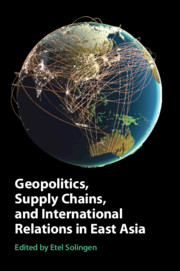Book contents
- Geopolitics, Supply Chains, and International Relations in East Asia
- Geopolitics, Supply Chains, and International Relations in East Asia
- Copyright page
- Dedication
- Contents
- Figures
- Tables
- Contributors
- Preface and Acknowledgements
- 1 Introduction: Geopolitical Shocks and Global Supply Chains
- Part I Global Supply Chains, Geopolitics, and Trade Wars
- Part II Domestic Political, Economic, and Social Dimensions of Global Supply Chains
- Part III Postscript on Covid-19
- 13 On Covid-19, Global Supply Chains, and Geopolitics
- References
- Index
13 - On Covid-19, Global Supply Chains, and Geopolitics
from Part III - Postscript on Covid-19
Published online by Cambridge University Press: 07 May 2021
- Geopolitics, Supply Chains, and International Relations in East Asia
- Geopolitics, Supply Chains, and International Relations in East Asia
- Copyright page
- Dedication
- Contents
- Figures
- Tables
- Contributors
- Preface and Acknowledgements
- 1 Introduction: Geopolitical Shocks and Global Supply Chains
- Part I Global Supply Chains, Geopolitics, and Trade Wars
- Part II Domestic Political, Economic, and Social Dimensions of Global Supply Chains
- Part III Postscript on Covid-19
- 13 On Covid-19, Global Supply Chains, and Geopolitics
- References
- Index
Summary
As all chapters were being readied for submission, Covid-19 erupted furiously in early 2020, compelling the effort to incorporate the pandemic’s initial effects on GSCs, the trade and technology war, and international relations within East Asia, in real time. Chapter 13 is, therefore, a postscript distilling findings from Parts I and II prior to Covid-19 while addressing the latter’s early effects on the chapters’ respective arguments. It then analyzes the strategies GSCs have embarked on in response to both geopolitical and pandemic shocks, building largely on preliminary 2020 survey data. Covid-19 accelerated the cumulative impact of geopolitical shocks and rising inward-oriented hyper-nationalist models, making GSCs more vulnerable than at any time since their initial expansion in the 1990s. Their ongoing restructuring and efforts to reduce overreliance on China suggest a potential decline in China’s status as factory of the world relative to the past, but hardly its demise. Migration out of China and reshoring remain more the anomaly than the norm for now. There is still uncertainty, however, as to whether geopolitics, technological competition, and the legacy of Covid-19 could unleash even more sizable disruptions in the global geography of production.
Keywords
- Type
- Chapter
- Information
- Publisher: Cambridge University PressPrint publication year: 2021
- 1
- Cited by

